Causative agents of HIV-AIDS and COVID-19 belong to the same group of viruses. To diagnose adn amplify the genetic material for further study of COVID-19 virus, 'RT-PCR' test is carried out.
What does 'RT-PCR' stand for ?
To answer the question regarding what 'RT-PCR' stands for, we can break down the components of the term:
1. Understanding RT-PCR:
- RT-PCR is a laboratory technique used to detect and amplify RNA (ribonucleic acid) sequences. It is particularly useful for studying viruses like COVID-19, which have RNA as their genetic material.
2. Breaking down the acronym:
- R: This stands for "Reverse". In the context of RT-PCR, it refers to the process of reverse transcription, where RNA is converted into complementary DNA (cDNA).
- T: This stands for "Transcriptase". This is the enzyme that catalyzes the reverse transcription process.
- P: This stands for "Polymerase". This refers to the enzyme that synthesizes new strands of DNA from the cDNA.
- C: This stands for "Chain".
- R: This stands for "Reaction".
3. Putting it all together:
- Therefore, RT-PCR stands for "Reverse Transcriptase Polymerase Chain Reaction". This technique is essential for diagnosing infections like COVID-19 by amplifying the viral RNA present in samples.
Final Answer: RT-PCR stands for Reverse Transcriptase Polymerase Chain Reaction.
---
- RT-PCR is a laboratory technique used to detect and amplify RNA (ribonucleic acid) sequences. It is particularly useful for studying viruses like COVID-19, which have RNA as their genetic material.
- R: This stands for "Reverse". In the context of RT-PCR, it refers to the process of reverse transcription, where RNA is converted into complementary DNA (cDNA).
- T: This stands for "Transcriptase". This is the enzyme that catalyzes the reverse transcription process.
- P: This stands for "Polymerase". This refers to the enzyme that synthesizes new strands of DNA from the cDNA.
- C: This stands for "Chain".
- R: This stands for "Reaction".
- Therefore, RT-PCR stands for "Reverse Transcriptase Polymerase Chain Reaction". This technique is essential for diagnosing infections like COVID-19 by amplifying the viral RNA present in samples.
Topper's Solved these Questions
- QUESTION PAPER 2022 SET-1BOOK - XII BOARDS PREVIOUS YEARCHAPTER - QUESTION PAPER 2022 SET-1EXERCISE - Section-C
5 Videos
- QUESTION PAPER 2022 SET-1BOOK - XII BOARDS PREVIOUS YEARCHAPTER - QUESTION PAPER 2022 SET-1EXERCISE - Section-C
5 Videos
- EXAM REVISION SERIESBOOK - XII BOARDS PREVIOUS YEARCHAPTER - EXAM REVISION SERIESEXERCISE - All Questions
32 Videos
- QUESTION PAPER 2022 SET-2BOOK - XII BOARDS PREVIOUS YEARCHAPTER - QUESTION PAPER 2022 SET-2EXERCISE - SECTION C
2 Videos
Similar Questions
There are two different farm lands, one where Bt-cotton crop was cultivated and the other where non Bt-cotton crop (indigenous) was cultivated. Farmers responsible for this experimental cultivation were free to use the farming practices of their choice. During the cultivation period, the data was collected with respect to the amount of pesticide used, water required for irrigation and at harvesting time, the crop productivity. Based on the data collected, a bar graph was plotted which is shown below.
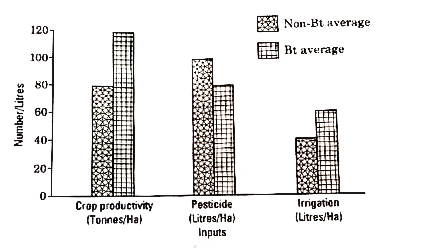
Answer teh following questions.
Write your interpretation, with reason, on the basis of the three parameters plotted in the graph.
View SolutionThere are two different farm lands, one where Bt-cotton crop was cultivated and the other where non Bt-cotton crop (indigenous) was cultivated. Farmers responsible for this experimental cultivation were free to use the farming practices of their choice. During the cultivation period, the data was collected with respect to the amount of pesticide used, water required for irrigation and at harvesting time, the crop productivity. Based on the data collected, a bar graph was plotted which is shown below.

Answer teh following questions.
Write your interpretation, with reason, on the basis of the three parameters plotted in the graph.
View SolutionEx-Situ vs In-Situ Conservation
View SolutionThere are two different farm lands, one where Bt-cotton crop was cultivated and the other where non Bt-cotton crop (indigenous) was cultivated. Farmers responsible for this experimental cultivation were free to use the farming practices of their choice. During the cultivation period, the data was collected with respect to the amount of pesticide used, water required for irrigation and at harvesting time, the crop productivity. Based on the data collected, a bar graph was plotted which is shown below.
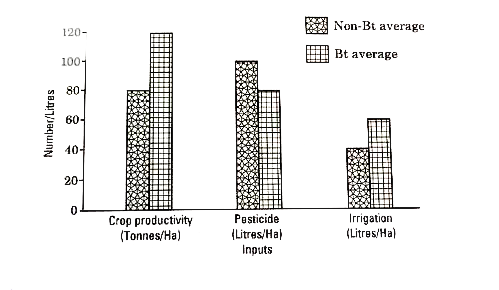
Answer the following questions:
(i) Write your interpretation, with reason, on the basis of the three parameters plotted in the graph.
(ii) Which one of the crops would you like to cultivate in your farm and why?
(iii) Which one out of these two crops would a farmer from Rajasthan like to cultivate and why?
View SolutionHow To Study from Home during Covid 19?
View SolutionA virus with ssDNA is discovered. Its DNA is amplified by running 19 cycles of PCR. How many dsDNA strand will be formed at the end ?
View SolutionHow RT-PCR technique is performed?
View SolutionWhat is RT-PCR?
View SolutionEssay Writing|Essay on Covid-19
View SolutionThe reliability of a COVID PCR test is specified as follows
Of people having COVID, 90% of the test detects the disease but 10% goes undetected. Of people free of COVID, 99% of the test is judged COVID negative but 1% are diagnosed as showing COVID positive. From a large population of which only 0.1% have COVID, one person is selected at random, given the COVID PCR test, and the pathologist reports him/her as COVID positive.

Based on the above information, answer the following
What is the probability of the ‘person to be tested as COVID positive’ given that ‘he is actually having COVID?
View SolutionThe reliability of a COVID PCR test is specified as follows
Of people having COVID, 90% of the test detects the disease but 10% goes undetected. Of people free of COVID, 99% of the test is judged COVID negative but 1% are diagnosed as showing COVID positive. From a large population of which only 0.1% have COVID, one person is selected at random, given the COVID PCR test, and the pathologist reports him/her as COVID positive.
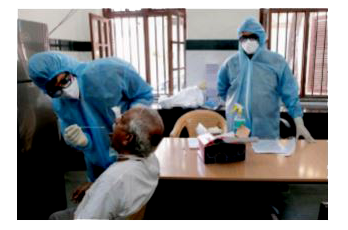
Based on the above information, answer the following
What is the probability of the ‘person to be tested as COVID positive’ given that ‘he is actually not having COVID’?
View SolutionThe reliability of a COVID PCR test is specified as follows
Of people having COVID, 90% of the test detects the disease but 10% goes undetected. Of people free of COVID, 99% of the test is judged COVID negative but 1% are diagnosed as showing COVID positive. From a large population of which only 0.1% have COVID, one person is selected at random, given the COVID PCR test, and the pathologist reports him/her as COVID positive.
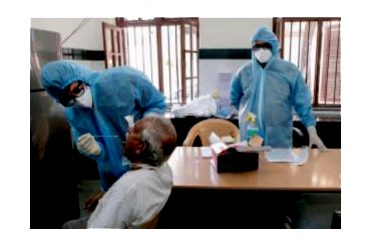
Based on the above information, answer the following
What is the probability that the ‘person is actually not having COVID?
View SolutionThe reliability of a COVID PCR test is specified as follows
Of people having COVID, 90% of the test detects the disease but 10% goes undetected. Of people free of COVID, 99% of the test is judged COVID negative but 1% are diagnosed as showing COVID positive. From a large population of which only 0.1% have COVID, one person is selected at random, given the COVID PCR test, and the pathologist reports him/her as COVID positive.
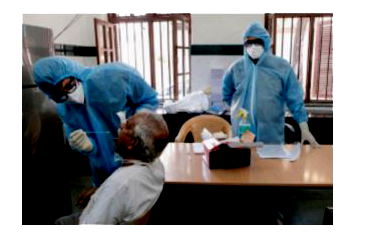
Based on the above information, answer the following
What is the probability that the ‘person is actually having COVID given that ‘he is tested as COVID positive’?
View SolutionThe reliability of a COVID PCR test is specified as follows
Of people having COVID, 90% of the test detects the disease but 10% goes undetected. Of people free of COVID, 99% of the test is judged COVID negative but 1% are diagnosed as showing COVID positive. From a large population of which only 0.1% have COVID, one person is selected at random, given the COVID PCR test, and the pathologist reports him/her as COVID positive.
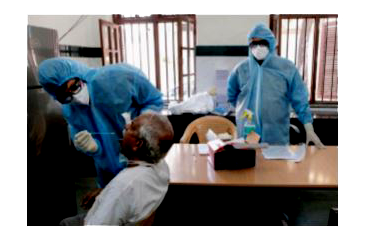
Based on the above information, answer the following
What is the probability that the ‘person selected will be diagnosed as COVID positive’?
View SolutionBrowse the information about Covid-19 with respect to Treatment.
View SolutionWhat is the PCR used to diagnose corona virus?
View Solution
